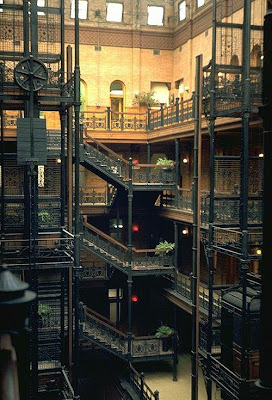
The justifiably famous Bradbury Building in Los Angeles occupies a special niche in my consciousness. Interestingly, as a native Californian I've had my entire life to visit this iconic place, but I never have.
As I write this, I live roughly two hours from Los Angeles. I've worked on commercial motion picture projects in the L.A. area many times. Visited that area on vacations. Passed through on road trips. Somehow I've never managed to see the Bradbury Building for myself, but it always felt like I could, at any time.
* * *
My father, the original film buff in my family both before and after I stumbled into the non-entertainment end of that profession, first called my attention to this building. He spoke fondly of it, pointed it out whenever it appeared on television, which it did with respectable regularity, short of overexposure, through the years. This was in the early 1960s, the decade of my American youth, but the movies we watched were often from previous decades.
I'm writing this purely from memory, now, a love letter to a beautiful and special place that has captured the imaginations of film directors, production designers, and writers for decades.
Ornate iron railings, walkways, balconies, labyrinthine floors, and somehow curious open design. The past dreaming of the future.
I recall it as a location for Outer Limits episodes, and various other television adventures requiring its unique atmopshere.
Perhaps its most famous appearance of all was in Ridley Scott's game-changing science fiction masterwork, Blade Runner, as the location of the hapless J.F. Sebastien's toy and doll-automata-filled apartment.
Seen through more recent eyes, it occurs to me the feel is what people are now calling steampunk. You would probably choose to spray everything down with water, shooting in the early morning hours. If you're using 35mm film, you could employ the laborious but effective bleach bypass process during post production to impart a steely and mysterious indigo blue.
As a potential location, it looms large in my cinematic imagination. From the very first time the idea crossed my mind even briefly, I've wondered from time to time what it might be like to direct a film there, create a project around it.
This morning, the Bradbury Building came to mind unexpectedly when I gave myself a thought-experiment to find a unique location for a couture fashion show. Once that particular mental lightbulb came on, the project designed itself. Before I'd taken the last sips of my first cup of coffee, I'd fully envisioned it. Who needs a runway?
The idea: a small audience is strategically seated in a cluster within the darkened interior. The stage is set, the anticipation electric.
First, there would be music: haunting, evocative in and of itself, but also offering accoustical description of the space to be revealed.
Instead of models coming down an illuminated runway, this couture show would feature a series of scenes, illuminated in turn, models doll-like and waiting on the several floors' various balconies and walkways. The concept is part movie still, part store window, part Cornell assemblage, and pure poetry.
* * *
This is a brief excerpt from the lovely website of USC Geography:
The Bradbury Building, built in 1893, is one of Southern California's most remarkable architectural achievements. Its plan was commissioned by real estate and mining entrepreneur Louis L. Bradbury who decided to build it just a few blocks from his home on fashionable Bunker Hill and not far from the base of Angels Flight. After rejecting a plan submitted by Sumner P. Hunt, Bradbury approached junior draftsman George Wyman. Wyman is said to have accepted the commission after consulting a ouija board. Wyman was influenced by Edward Bellamy's 1887 book that described a utopian civilization in the year 2000. The typical office building was described as being a "vast hall of light received not alone by the windows, but from a dome overhead." The interior of the court is flooded with natural light. In the true spirit of Los Angeles, it has been featured in many movies, from DOA in 1946 to Blade Runner in 1982.
Images-- a great number of them-- can be easily found online.
Why has it taken me this long to check on the details? Why have I never seen this location for myself? My theory around this has to do with forestalling the end of the dream and the beginning of reality: for instance, I just learned there is a Subway sandwich place on the building's main floor, not exactly consistent with my fantasies. But there's something else, too, at work here. We save certain things as an exercise in immortality. There will always be more time, there will always be a chance. Considering this: the longer I go between phone calls to my father, the longer he'll be around, a finger on the pause button.
Knowing I will someday see the Bradbury Building for myself gives me a reassuring sense of endless time. I've driven past it on countless occasions. For now, it is vivid in my mind, a done deal, a set of ideas, an evocation, a sense of possibility and potential and future memories that exist deep within my aesthetic psyche.
Having envisioned the space I can even see the couture itself. Magical and haunting, heroines of great dreams and stories half-remembered upon awakening. A mashup of dreams of a suburban girl growing up in the late fifties and early sixties. A subject for another day.
Best regards,
brenda
* * *
